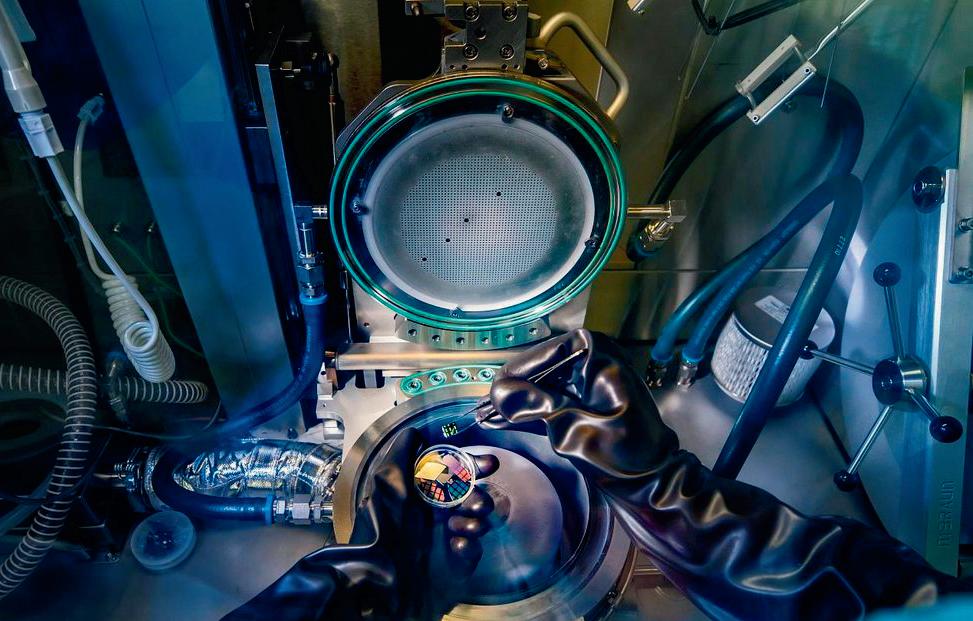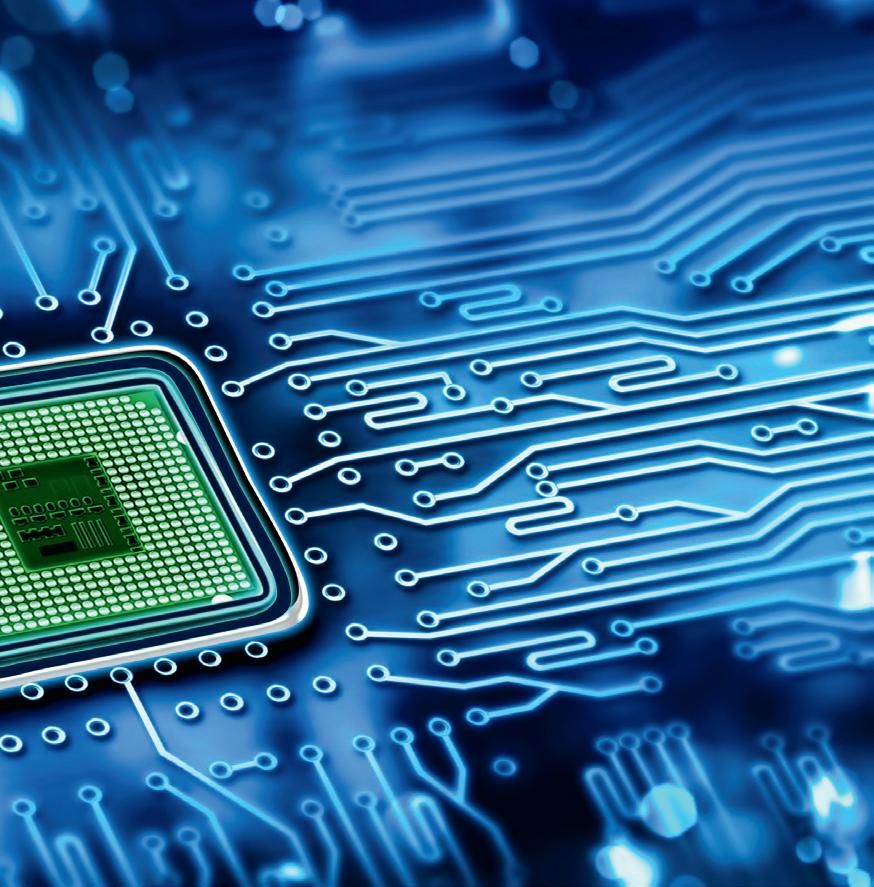
8 minute read
Light-emitting silicon paves the way for photonic chips
Emitting light from silicon has been the ‘Holy Grail’ of the microelectronics industry for decades, as it would enable chips to become faster than ever. Now, European researchers have reported the development of an alloy with silicon that can emit light, and will begin work on a silicon laser to be integrated into current chips.
Every year we use and produce significantly more data — but current technology, based on electronic chips, is reaching its ceiling. The limiting factor is heat, resulting from the resistance that the electrons experience when travelling through the copper lines connecting the many transistors on a chip. If we want to continue transferring more and more data every year, we need a new technique that does not produce heat. Enter photonics, which uses photons (light particles) to transfer data.
In contrast to electrons, photons do not experience resistance. As they have no mass or charge, they will scatter less within the material they travel through, and therefore no heat is produced. The energy consumption will therefore be reduced. Moreover, by replacing electrical communication within a chip by optical communication, the speed of on-chip and chip-tochip communication can be increased by a factor of 1000. Data centres would benefit most, with faster data transfer and less energy usage for their cooling system. But these photonic chips will also bring new applications within reach — think of laser-based radar for self-driving cars and chemical sensors for medical diagnosis or for measuring air and food quality.
Dropping electron emits a photon To use light in chips, you will need a light source; an integrated laser. The main semiconductor material that computer chips are made of is silicon. But bulk silicon is extremely inefficient at emitting light, and so was long thought to play no role in photonics. Thus, scientists turned to more complex semiconductors, such as gallium arsenide and indium phosphide. These are good at emitting light but are more expensive than silicon and are hard to integrate into existing silicon microchips.
To create a silicon-compatible laser, scientists needed to produce a form of silicon that can emit light. That’s exactly what researchers from Eindhoven University of Technology (TU/e) have done. Together with researchers from the Universities of Jena, Linz and Munich, they combined silicon and germanium in a hexagonal structure that is able to emit light — a breakthrough 50 years in the making, now published in the journal Nature.
Hexagonal structure “The crux is in the nature of the so-called band gap of a semiconductor,” said lead researcher Erik Bakkers from TU/e. “If an electron ‘drops’ from the conduction band to the valence band, a semiconductor emits a photon: light.”

Co-first authors Elham Fadaly and Alain Dijkstra operating an optical set-up to measure the light that is emitted.

A look inside the Metal Organic Vapor Phase Epitaxy (MOVPE) — the machine that was used to grow the nanowires with hexagonal silicon-germanium shells.

© Stock.Adobe.com/au/refresh(PIX)
But if the conduction band and valence band are displaced with respect to each other, which is called an indirect band gap, no photons can be emitted — as is the case in silicon. “A 50-year-old theory showed however that silicon, alloyed with germanium, shaped in a hexagonal structure does have a direct band gap, and therefore potentially could emit light,” Bakkers said.
Shaping silicon in a hexagonal structure, however, is not easy. As Bakkers and his team master the technique of growing nanowires, they were able to create hexagonal silicon in 2015. They realised pure hexagonal silicon by first growing nanowires made from another material, with a hexagonal crystal structure. Then they grew a silicon-germanium shell on this template. Elham Fadaly, co-first author of the study, said, “We were able to do this such that the silicon atoms are built on the hexagonal template, and by this forced the silicon atoms to grow in the hexagonal structure.”
But they could not yet make these devices emit light, until now.
Silicon laser Bakkers’ team managed to increase the quality of the hexagonal silicon-germanium shells by reducing the number of impurities and crystal defects. When exciting the nanowire with a laser, they could measure the efficiency of the new material. Co-first author Alain Dijkstra, responsible for measuring the light emission, said, “Our experiments showed that the material has the right structure and that it is free of defects. It emits light very efficiently.”
Creating a laser is now a matter of time, Bakkers claimed. “By now we have realised optical properties which are almost comparable to indium phosphide and gallium arsenide, and the materials quality is steeply improving. If things run smoothly, we can create a silicon-based laser in 2020. This would enable a tight integration of optical functionality in the dominant electronics platform, which would break open prospects for on-chip optical communication and affordable chemical sensors based on spectroscopy.”
In the meantime, the team is also investigating how to integrate the hexagonal silicon in cubic silicon microelectronics, which is an important prerequisite for this work.
SECURITY-ENABLED SBC Aitech’s latest security-enabled SBC (single-board computer) features up to 16 lanes of PCIe to handle increased data processing requirements, while protecting the board from data attacks and cyber threats. The C878 is a 3U VPX board that provides Intel Xeon D level processing in a rugged, industry-standard form factor. Equipped with double the Gen3 PCIe Data Plane lanes as Aitech’s C877, the rugged SBC was specifically designed using a modern, high-bandwidth bus architecture and can accommodate an increased amount of backplane traffic. This makes it suitable for compute-intensive, mission-critical applications found in harsh environments.
Instead of supporting an XMC site, the SBC includes a GPU to provide an intuitive interface via a 128-bit 2D graphics engine. These HMI capabilities allow the user to interact and control the application graphically or display pertinent data/video or other info on a monitor/screen. The hardware video decoder in the GPU supports many video outputs, including MPEG-2, MPEG-4, VC-1, H.264 MVC/AVS+ and JPEG/MJPEG.
The product uses Aitech’s proprietary AiSecure cybersecurity architecture to provide secure transmission of sensitive data. Intel security includes Trusted Platform and Secure Boot as well as a BIOS Guard based on TXT TPM 2.0 and BIOS security. The onboard SATA SSD, up to 1 TB, supports write protection, secure and quick erase in addition to disk data encryption using AES 256 keys. A battery-backed tamper detection signal ensures system level protection.
A variety of onboard I/O interfaces, including USB 3.0/2.0, SATA III, PCIe Gen2, serial, discrete, DVI out and Ethernet, as well as custom I/O via the FPGA, are available on the OpenVPX-based SBC. The board also offers up to 32 GB of DDR4 SDRAM with ECC at 2133 MT/s to meet storage requirements.
The product comes in conduction- and air-cooled versions and features several board resources, such as watchdog timers, a real-time clock, temperature sensors, an elapsed time recorder and VITA 46.11 Tier 1 and Tier 2 IPMI. Supported operating systems are Windows, WindRiver VxWorks and Linux. APC Technology www.apctechnology.com.au


Who the #?!&*% is…

• Operating since 1980. • Contract manufacturer,
UL compliant, with engineering capability. • Your products may change but your contract manufacturer doesn’t have to.

How to find a reliable contractor! Team up with us for the long haul. • We create a quality plan for every product we make for you. • Contact us for a free quote. MOISTURE PROTECTION FOR SPLICING CONNECTORS When moisture meets electricity, a short circuit can happen quickly. However, casting compound has shown itself to provide good protection.
Ready for instant deployment, reaccessible and with a high storage capacity, WAGO’s Gelbox can be used to protect splicing connectors from moisture and humidity, such as that found outdoors. The product clears a path to achieving IPX8 levels of moisture protection in a quick and easy way: simply open the box, insert the connector and close the box.
The polyurethane gel used is silicone-free, making the Gelbox ready to use in any branch of industry — even those where varnishes, paints and other sensitive products are used. In addition, the gel has already reacted and is therefore label-free.
The device is available in six sizes and can be used in a wide variety of low- and extra-low-voltage applications. It is compatible with WAGO’s 221 Series COMPACT Splicing Connectors and 2273 Series COMPACT PUSH WIRE Connectors. WAGO Pty Ltd www.wago.com.au

POWER SUPPLY Developed using Vicor high-density and high-efficiency ChiP power modules, the VITA 62 compliant power supply is designed for 6U OpenVPX conduction-cooled chassis systems.
The product operates from a nominal 28 V input with predefined output voltages ranging from 3.3 to 12 V and delivering up to 1000 W of power. Users requiring different output voltages or power levels can request a customised power supply to meet their own specifications.
The 6U supply fully meets MIL-461F, MIL-704F and MIL-1275E standards. Vicor Corporation www.vicorpower.com

RF SIGNAL GENERATORS SIGLENT’s SSG5000X series of signal generators can generate analog and vector signals. They have a frequency range of 9 kHz to 4/6 GHz and offer high performance in phase noise, spectral purity, bandwidth, EVM and output power.
The internal IQ modulation generator and waveform playback function make it easy to create even complex signal types. The series also covers the most important RF band for digital wireless communications and includes standard waveform files.
The signal generators are suitable for R&D, education and manufacturing. IPD Group Limited www.ipd.com.au








